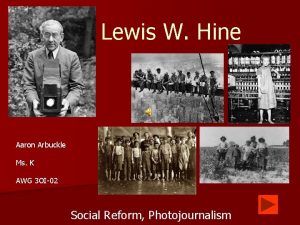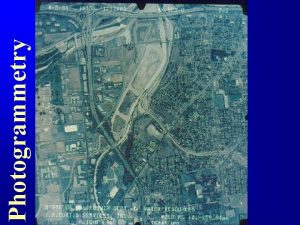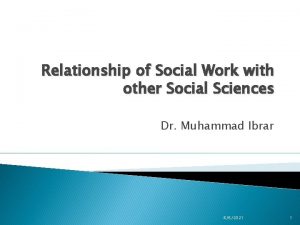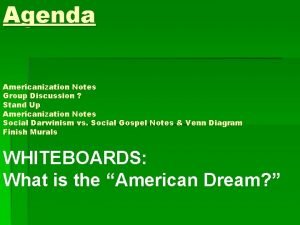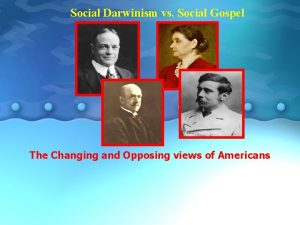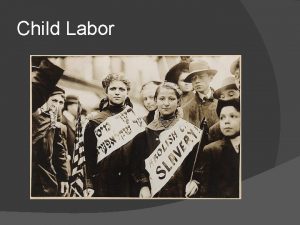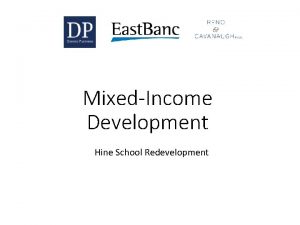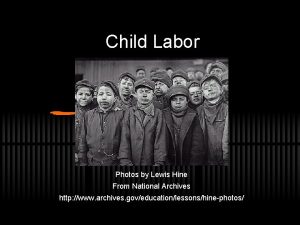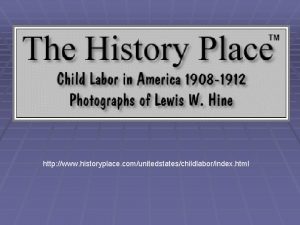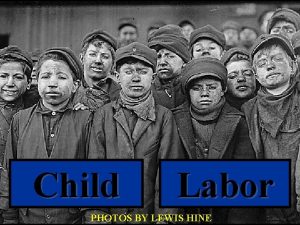The Social Photography of Lewis Hine and The


































![Michael Mc. Nelis, age 8, a newsboy [seen with photographer Hine]. This boy has Michael Mc. Nelis, age 8, a newsboy [seen with photographer Hine]. This boy has](https://slidetodoc.com/presentation_image_h2/61f94f9d33f96ca4951543dac2bb1a1c/image-35.jpg)






















































![Michael Mc. Nelis, age 8, a newsboy [seen with photographer Hine]. This boy has Michael Mc. Nelis, age 8, a newsboy [seen with photographer Hine]. This boy has](https://slidetodoc.com/presentation_image_h2/61f94f9d33f96ca4951543dac2bb1a1c/image-90.jpg)



- Slides: 93

The Social Photography of Lewis Hine and The Child Labor Reform Movement 1880 - 1918

• • What was the nature and extent of Child Labor in the Gilded Age and Progressive Period? How did the National Child Labor Committee work to “reform” the conditions of child labor? What was the nature and impact of Lewis Hine’s “social photography, ” particularly his child labor photographs? How might the Lewis Hine’s child labor photographs and his social photography approach be used in history instruction? Lewis Hine, Photographer. At 5 p. m. , boys going home from Monougal Glass Works. One boy remarked, "De place is lousey wid kids. " Fairmont, West Virginia.

“This act modifies the child labor laws. It eliminates the prohibition on employment of children under age fourteen. Restrictions on the number of hours and restrictions on when a child may work during the day are also removed. It also repeals the requirement that a child ages fourteen or fifteen obtain a work certificate or work permit in order to be employed. Children under sixteen will also be allowed to work in any capacity in a motel, resort or hotel where sleeping accommodations are furnished. It also removes the authority of the director of the Division of Labor Standards to inspect employers who employ children and to require them to keep certain records for children they employ. It also repeals the presumption that the presence of a child in a workplace is evidence of employment. ” -Official Summary of a bill introduced into the Missouri Senate by State Senator Jane Cunningham (R)

“We are likely to find ourselves. . . facing a situation in which our chief task is not to imagine better worlds but rather to think how to prevent worse ones, how to keep what we have gained by virtue of arduous struggles of those who have proceeded us. ” - Tony Judt (1945 - 2010)

What is Child Labor? In many developed countries, it is considered inappropriate or exploitative if a child below a certain age works (excluding household chores, in a family shop, or school-related work). An employer is usually not permitted to hire a child below a certain minimum age. This minimum age depends on the country and the type of work involved. States ratifying the Minimum Age Convention adopted by the International Labor Organization in 1973, have adopted minimum ages varying from 14 to 16. Child labor laws in the United States set the minimum age to work in an establishment without restrictions and without parents' consent at age 16 except for the agricultural industry where children as young as 12 years of age can work in the fields for an unlimited number of non-school hours

“The Insidious Trend” • The number of children under age 16 working doubled between 1890 -1900, from 1. 1 million to 1. 8 million By 1900, about 1 in every 6 children between the ages of five and ten were engaged in “gainful occupations” in the United States. • In 1900, 18% of children aged 10 -15 were employed, but these recorded numbers understate the actual number or percentage of all children employed, which might have been as high as 30%. • Children under age 15 composed 25% of cotton industry workforce in 1900 and the ratio of children to adult workers was the highest in any industry. • In the anthracite and bituminous coal mining industries, boys almost exclusively filled three occupations: slate picker, door tender, and mule driver. • Children worked in most industries: glass factories canneries. • Most newspaper vendors and messenger boys were juveniles.

Some of the workers in the Farrand Packing Co. Baltimore, Maryland. Photographer: Lewis Hine

Why hire children? Employers hired children because they were cheap and relatively malleable • • Slate picker: 6 -10 cents/hr. Meat packer: 2 cents/hr. Glass factory hand: 3 cents/hr. Cannery worker: 2. 5 cents/hr. Sweatshops: 1 -2 cents/hr. Train yard helper: 1 -2 cents/hr. Mule Driver: 6 -10 cents/hr. Three young boys with shovels standing in doorway of a Fort Worth & Denver train car. Cotton mills: 5 cents/hour for experienced 12 year olds. (Some mills gave children the “opportunity” to gain experience by allowing them to work without pay for a probationary period of up to six weeks. At the end of the period, they often would be fired and replaced by a new set of children on probationary status. )

A textile mill. Sweeper and doffer boys in Lancaster Cotton Mills, Lancaster, S. C. Photograph by Lewis Wickes Hine, December 1, 1908.

Pastimes and Vices Richard Pierce, age 14. A Western Union Telegraph Co. messenger. Nine months in service, works from 7 a. m. to 6 p. m. Smokes and visits houses of prostitution. Wilmington, Delaware. Photographer: Lewis Hine

Two factory girls protesting child labor (by calling it child slavery) New York City Labor Day parade, May 1, 1909

The National Child Labor Committee (1904 - Present) In 1902 an Episcopalian minister, the Reverend Edgar Gardner Murphy, founded the Alabama Child Labor Committee. The next year representatives of thirty-two New York City settlement houses formed the New York Child Labor Committee. These groups collaborated on August 15, 1904, to establish the National Child Labor Committee (NCLC), which was incorporated in 1907 with a board that included prominent Progressive reformers. Edgar Gardner Murphy (1869 - 1913)

Progressive Social Reform: Redefining “Social Problems” and their Solutions • Shift from blaming the poor to emphasizing social injustice, from individual charity to social reform. • Shift from “pauperism” (assuming that poverty arises from poor character and morally incorrect behavior) to regarding the poor as the victims of social arrangements and social forces. • Shift to a belief that modern science, methods of efficiency, and social planning could be forces of positive social change, if wielded with the right intentions and not left in the hands of a wealthy elite. • Shift from random charitable “giving’” to a more systemic, rationalized, and professional approach to solving social problems. • Shift from an emphasis on private philanthropy to solutions that required publicity, political lobbying, legislative intervention, and professional expertise. Hull House Social Worker and Clients, 1890’s • Connecting reforming purpose with the latest methods of scientific inquiry, such as the Pittsburgh Survey. • Shift from amateur philanthropists towards trained professionals (social scientists, social workers, community health/sanitation personnel) using scientific methods, publicity and political organizing to achieve social change. Hull House Map of Nationalities, Chicago, 1893

Jane Addams (1860 -1935) Hull House Edward T. Devine (1867 – 1948) - Economist - The Pittsburgh Survey The National Child Labor Committee (NCLC) Board of Directors Lillian Wald Florence Kelley (1867 – 1940) (1859 – 1932) - Founder National Consumers League - Chief Factory Inspector, Illinois - Co-founder, NAACP "Florence is the toughest customer in the reform riot, the finest rough-and-tumble fighter for the good life for others” - Jane Addams - Henry Street Settlement - Community Nursing - Co- Founder, NAACP - U. S. Children’s Bureau - Women’s League for Peace and Freedom

Lewis Wickes Hine 1874 -1940

“Social Betterment” by Teaching Compassionate Seeing “We must contrast the evolutionary character of education to those reforms that are transitory and futile, which rest simply upon the enactment of law, or the threatening of certain penalties, or upon changes in mechanical or outward arrangements. ” “We must restore the continuity between the refined and intensified forms of experience that are works of art and the everyday events, doings, and sufferings that are universally recognized to constitute experience. ” John Dewey (1859 - 1952)

How did he do it? Lewis Hine photographing


Featuring the original photo captions by Lewis W. Hine http: //www. historyplace. com/unitedstates/childlabor/index. html

Newboys under the Brooklyn Bridge at Midnight

Furman Owens 12 years old. Columbia, S. C. Can't read. Doesn't know his A, B, C's. Said, "Yes I want to learn but can't when I work all the time. " Been in the mills 4 years, 3 years in the Olympia Mill.

Adolescent girls from Bibb Mfg. Co. in Macon, Georgia. Doffer boys. Macon, Georgia.

Children in the Mills A general view of spinning room, Cornell Mill. Fall River, Massachusetts.

A moment's glimpse of the outer world. Said she was 11 years old. Been working over a year. Rhodes Mfg. Co. Lincolnton, North Carolina.

Some boys and girls were so small they had to climb up on to the spinning frame to mend broken threads and to put back the empty bobbins. Bibb Mill No. 1. Macon, Georgia.

One of the spinners in Whitnel Cotton Mill. She was 51 inches high. Has been in the mill one year. Sometimes works at night. Runs 4 sides - 48 cents a day. When asked how old she was, she hesitated, then said, "I don't remember, " then added confidentially, "I'm not old enough to work, but do just the same. " Out of 50 employees, there were ten children about her size. Whitnel, North Carolina.

The overseer said apologetically, "She just happened in. " She was working steadily. The mills seem full of youngsters who "just happened in" or "are helping sister. " Newberry, South Carolina.

Jo Bodeon, a back-roper in the mule room at Chace Cotton Mill. Burlington, Vermont.

The Newsies “As to the little boys in industry, we have an old assumption that the boy we see on the sidewalk will some day be the Marshall Field or John Wanamaker of his generation. There is no foundation for that. Marshall Field was never a newsboy, and I do not know that John Wanamaker ever was one. We have no evidence that street boys grow into heroes of commerce. We are really encouraging them to be beggars and thieves when we allow them to keep change which they should return if they are ever going to be business men. ” - Florence Kelley Text

The “Newsies” A small newsie downtown on a Saturday afternoon. St. Louis, Missouri.

A group of newsies selling on the Capitol steps. Tony, age 8, Dan, 9, Joseph, 10, and John, age 11. Washington, D. C.

Tony Casale, age 11, been selling 4 years. Sells sometimes until 10 p. m. His paper told me the boy had shown him the marks on his arm where his father had bitten him for not selling more papers. He (the boy) said, "Drunken men say bad words to us. " Hartford, Connecticut.

Out after midnight selling extras. There were many young boys selling very late. Youngest boy in the group is 9 years old. Harry, age 11, Eugene and the rest were a little older. Washington, D. C.

Newsboy asleep on stairs with papers. Jersey City, New Jersey.
![Michael Mc Nelis age 8 a newsboy seen with photographer Hine This boy has Michael Mc. Nelis, age 8, a newsboy [seen with photographer Hine]. This boy has](https://slidetodoc.com/presentation_image_h2/61f94f9d33f96ca4951543dac2bb1a1c/image-35.jpg)
Michael Mc. Nelis, age 8, a newsboy [seen with photographer Hine]. This boy has just recovered from his second attack of pneumonia. Was found selling papers in a big rain storm. Philadelphia, Pennsylvania.

Francis Lance, 5 years old, 41 inches high. He jumps on and off moving trolley cars at the risk of his life. St. Louis, Missouri.

The Child Miners Joe Puma At the close of day. Waiting for the cage to go up. The cage is entirely open on two sides and not very well protected on the other two, and is usually crowded like this. The small boy in front is Jo Puma. South Pittston, Pennsylvania.

View of the Ewen Breaker of the Pennsylvania Coal Co. The dust was so dense at times as to obscure the view. This dust penetrated the utmost recesses of the boys' lungs. A kind of slave-driver sometimes stands over the boys, prodding or kicking them into obedience. South Pittston, Pennsylvania.

Noon hour in the Ewen Breaker, Pennsylvania Coal Co. South Pittston, Pennsylvania.

Work injury to coal mine breaker boy: loss of an eye.

“Luther Watson of Kentucky is 14 years old. His right arm was cut off by a veneering saw in a box factory in Cincinnati a month ago. . . November 1908. ” “He worked in the bung factory. He walked past one of the machines, and it got switched on somehow and his arm got twisted up in it. It was terrible. His parents were dead when he had the injury. “

Questions for Instructional Activities around Child Labor • Do these children look "young" as most children today do? • Why did employers hire young children? • Why did their parents let them work? • Describe the kind of work they did. How long they work in a day? • What are their working conditions. Where did they work? When did they work? Do children today face any dangers that the children in these photographs faced when working? • How do you think adults treated children on the job? • How much did they get paid? • What might have been done to make their life better?

Breaker boys, Hughestown Borough Pennsylvania Coal Company. One of these is James Leonard, another is Stanley Rasmus. Pittston, Pennsylvania.

Breaker boys. Smallest is Angelo Ross. Pittston, Pennsylvania.

Harley Bruce, a young coupling-boy at Indian Mine. He appears to be 12 or 14 years old and says he has been working there about a year. It is hard work and dangerous. Near Jellico, Tennessee.

A young driver in the Brown Mine. Has been driving one year. Works 7 a. m. to 5: 30 p. m. daily. Brown, West Virginia.


The Factory View of the Scotland Mills, showing boys who work in mill. Laurinburg, North Carolina.

9 p. m. in an Indiana Glass Works.

Midnight at the glassworks

Day scene. Wheaton Glass Works. Boy is Howard Lee. His mother showed me the family record in Bible which gave his birth as July 15, 1894. 15 years old now, but has been in glass works two years and some nights. Millville, New Jersey.

Robert Kidd Rob Kidd, one of the young workers in a glass factory. Alexandria, Virginia.

Some of the young knitters London Hosiery Mills. London, Tennessee.

Young cigar makers in Engelhardt & Co. Three boys looked under 14. Labor leaders told me in busy times many small boys and girls were employed. Youngsters all smoke. Tampa, Florida.

The Food Industry Oyster shuckers working in a canning factory. All but the very smallest babies work. Began work at 3: 30 a. m. and expected to work until 5 p. m. The little girl in the center was working. Her mother said she is "a real help to me. " Dunbar, Louisiana.

Shrimp pickers, including little 8 -year-old Max on the right. Biloxi, Mississippi.

Johnnie, a 9 -year-old oyster shucker. Man with pipe behind him is a Padrone who has brought these people from Baltimore for four years. He is the boss of the shucking shed. Dunbar, Louisiana.

Cutting fish in a sardine cannery. Large sharp knives are used with a cutting and sometimes chopping motion. The slippery floors and benches and careless bumping into each other increase the liability of accidents. "The salt water gits into the cuts and they ache, " said one boy. Eastport, Maine.

Hiram Pulk, age 9, working in a canning company. "I ain't very fast only about 5 boxes a day. They pay about 5 cents a box, " he said. Eastport, Maine.

Agricultural Labor Camille Carmo, age 7, and Justine, age 9. The older girl picks about 4 pails a day. Rochester, Mass.

Three boys, one of 13 yrs. , two of 14 yrs. , picking shade-grown tobacco on Hackett Farm. The "first picking" necessitates a sitting posture. Buckland, Connecticut.

Six-year-old Warren Frakes. Mother said he picked 41 pounds yesterday "An I don't make him pick; he picked some last year. " Has about 20 pounds in his bag. Comanche County, Oklahoma.

Twelve-year-old Lahnert boy topping beets. The father, mother, and two boys (9 and 12 yrs. ) expect to make $700 in about 2 months time in the beet work. "The boys can keep up with me all right, and all day long, " the father said. Begin at 6 a. m. and work until 6 p. m. with hour off at noon. Fort Collins, Colorado.

Norris Luvitt. Been picking 3 years in berry fields near Baltimore.

Struggling Families A Jewish family and neighbors working until late at night sewing garters. This happens several nights a week when there is plenty of work. The youngest work until 9 p. m. The others until 11 p. m. or later. On the left is Mary, age 7, and 10 -year-old Sam, and next to the mother is a 12 year-old boy. On the right are Sarah, age 7, next is her 11 year old sister, 13 -year-old brother. Father is out of work and also helps make garters. New York City.

A family working in the Tifton Cotton Mill. Four smallest children not working yet. The mother said she earns $4. 50 a week and all the children earn $4. 50 a week. Husband died and left her with 11 children. Two of them went off and got married. The family left the farm two years ago to work in the mill. Tifton, Georgia.

Picking nuts in dirty basement. The dirtiest imaginable children were pawing over the nuts and eating lunch on the table. Mother had a cold and blew her nose frequently (without washing her hands) and the dirty handkerchiefs reposed comfortably on table close to the nuts and nut meats. The father picks now. New York City.

A Brief History of Child Labor Reform Efforts Proposed Solution Compulsory Education: Increase the number of years of compulsory education Immediate Result Americanize immigrant children by teaching them English and giving them “correct” values by keeping them out of the workplace. Some states passed child labor laws: State Child Labor Laws: Labor unions and reformers also lobbied for laws restricting the hours a child could work Federal Child Labor Law: Lax or nonexistent enforcement of state laws regulating child labor led progressive reformers to seek a federal child labor law. By 1900 eight states prohibited children from working at night. Most northern states mandated a 10 -hour day and 60 -hour week for children. Many states also established a minimum age for industrial work. By 1912 only nine states had laws prohibiting the employment of children under the age of 14 in factories; under the age of 16 in mines, and required an 8 hour work day for children ages 14 to 16. Keating-Owen Act (1917): Prohibited the sale in interstate commerce of goods manufactured by children in the United States Final Outcome Compulsory education did not solve the problem because schools, bowing to pressure from manufacturers, established night schools for working children. Minimum-age laws had little effect: employers did not inquire too closely into the ages of children who worked for them and children often lied about their age, out of economic necessity to work and help support their families. Wages were so low that a family could not subsist on just one or two salaries. Hammer vs. Daghart (1918): The Supreme Court struck down the Keating-Owen Act as unconstitutional. The court challenge was made by the Southern Cotton Manufacturers. The court ruled that Keating-Owen was an unwarranted exercise of the federal government’s powers and an invasion of state rights.

What Hine and the NCLC missed. Juvenile Prisoners working the fields Alabama

Convict wagons like these in Pitt County, North Carolina, 1910, were used across the South to transport and house African-Americans, many of them juveniles ages 12 to 6, compelled to work in road gangs, lumber camps, and farms.

Young prisoner tied around a pickax for punishment in a Georgia labor camp

What is the rest of the story? Recovering the Life Stories of Lewis Hine’s Child Laborers (or, the Magic of Ancestry. com) The Breaker Boys


Day scene. Wheaton Glass Works. Boy is Howard Lee. His mother showed me the family record in Bible which gave his birth as July 15, 1894. 15 years old now, but has been in glass works two years and some nights. Millville, New Jersey.


Occupation: plumber


Harley Bruce, a young coupling-boy at Indian Mine. He appears to be 12 or 14 years old and says he has been working there about a year. It is hard work and dangerous. Near Jellico, Tennessee.

Occupation: Laborer, Coal Mine

“Luther Watson of Kentucky is 14 years old. His right arm was cut off by a veneering saw in a box factory in Cincinnati a month ago. . . November 1907. ”

Mabel and Luther Watson and grandsons, 1938 Mabel and Luther Watson, 1940’s Daughters: Della and Nola Watson, 1940’s Luther Thomas Watson was born on July 09, 1892, in Grant County, Kentucky. His parents were John and Lucy Powell Watson. He married Mabel Celia Freeman on April 18, 1914, in Ohio. Luther passed away on July 27, 1961, at the age of 69, and wife Mabel died on June 25, 1972, at the age of 75. I found Luther in the 1920 census. He was living in Covington, Kentucky, with his wife and two girls. His occupation was listed as a telegraph messenger. In the 1930 census, he was listed as living in Elsmere, Kentucky, with two additional girls, and he was employed as a switch tender for the railroad.

Breaker boys, Hughestown Borough Pennsylvania Coal Company. One of these is James Leonard, another is Stanley Rasmus. Pittston, Pennsylvania.

Occupation: Linotyper, Printing Office

Occupation: City Policeman

The Child Miners Joe Puma At the close of day. Waiting for the cage to go up. The cage is entirely open on two sides and not very well protected on the other two, and is usually crowded like this. The small boy in front is Jo Puma. South Pittston, Pennsylvania.

Occupation: coal miner

Robert Kidd Rob Kidd, one of the young workers in a glass factory. Alexandria, Virginia.

Occupation: Helper, glass factory

Robert Ellis Kidd Birth: 29 Sept 1898 Death: 30 May 1960 in Alexandria, VA Parents: Joseph Montgomery Kidd (1854 1932 ) Ada Elica Buffrey (1863 -1903) Spouses: Eleanor Blanche Mitchel (1907 2009) 1907 – 2009 Occupation: Clerk, Oil Company Office
![Michael Mc Nelis age 8 a newsboy seen with photographer Hine This boy has Michael Mc. Nelis, age 8, a newsboy [seen with photographer Hine]. This boy has](https://slidetodoc.com/presentation_image_h2/61f94f9d33f96ca4951543dac2bb1a1c/image-90.jpg)
Michael Mc. Nelis, age 8, a newsboy [seen with photographer Hine]. This boy has just recovered from his second attack of pneumonia. Was found selling papers in a big rain storm. Philadelphia, Pennsylvania.

Michael Mc. Nelis BIRTH: 15 Sep 1901 - Philadelphia, United States PARENTS: None MARRIAGE: 1953 - Wilkes-Barre, Luzerne, Pennsylvania DEATH: 15 Apr 1971 - Wilkes-Barre, Luzerne, Pennsylvania, SPOUSE: Gertrude Costello Thomas Mc. Nelis (1897 -1988)


Lest we forget. Lest we lose.
 Aaron arbuckle
Aaron arbuckle Is abstract photography same as conceptual photography
Is abstract photography same as conceptual photography Lewis carroll photography
Lewis carroll photography Apa itu social thinking
Apa itu social thinking Social thinking social influence social relations
Social thinking social influence social relations Social darwinism vs social gospel answer key
Social darwinism vs social gospel answer key Hình ảnh bộ gõ cơ thể búng tay
Hình ảnh bộ gõ cơ thể búng tay Ng-html
Ng-html Bổ thể
Bổ thể Tỉ lệ cơ thể trẻ em
Tỉ lệ cơ thể trẻ em Voi kéo gỗ như thế nào
Voi kéo gỗ như thế nào Chụp phim tư thế worms-breton
Chụp phim tư thế worms-breton Chúa yêu trần thế
Chúa yêu trần thế Môn thể thao bắt đầu bằng chữ f
Môn thể thao bắt đầu bằng chữ f Thế nào là hệ số cao nhất
Thế nào là hệ số cao nhất Các châu lục và đại dương trên thế giới
Các châu lục và đại dương trên thế giới Công thức tính thế năng
Công thức tính thế năng Trời xanh đây là của chúng ta thể thơ
Trời xanh đây là của chúng ta thể thơ Cách giải mật thư tọa độ
Cách giải mật thư tọa độ Phép trừ bù
Phép trừ bù Phản ứng thế ankan
Phản ứng thế ankan Các châu lục và đại dương trên thế giới
Các châu lục và đại dương trên thế giới Thể thơ truyền thống
Thể thơ truyền thống Quá trình desamine hóa có thể tạo ra
Quá trình desamine hóa có thể tạo ra Một số thể thơ truyền thống
Một số thể thơ truyền thống Cái miệng xinh xinh thế chỉ nói điều hay thôi
Cái miệng xinh xinh thế chỉ nói điều hay thôi Vẽ hình chiếu vuông góc của vật thể sau
Vẽ hình chiếu vuông góc của vật thể sau Nguyên nhân của sự mỏi cơ sinh 8
Nguyên nhân của sự mỏi cơ sinh 8 đặc điểm cơ thể của người tối cổ
đặc điểm cơ thể của người tối cổ Ví dụ về giọng cùng tên
Ví dụ về giọng cùng tên Vẽ hình chiếu đứng bằng cạnh của vật thể
Vẽ hình chiếu đứng bằng cạnh của vật thể Fecboak
Fecboak Thẻ vin
Thẻ vin đại từ thay thế
đại từ thay thế điện thế nghỉ
điện thế nghỉ Tư thế ngồi viết
Tư thế ngồi viết Diễn thế sinh thái là
Diễn thế sinh thái là Dạng đột biến một nhiễm là
Dạng đột biến một nhiễm là Thế nào là số nguyên tố
Thế nào là số nguyên tố Tư thế ngồi viết
Tư thế ngồi viết Lời thề hippocrates
Lời thề hippocrates Thiếu nhi thế giới liên hoan
Thiếu nhi thế giới liên hoan ưu thế lai là gì
ưu thế lai là gì Hổ sinh sản vào mùa nào
Hổ sinh sản vào mùa nào Sự nuôi và dạy con của hổ
Sự nuôi và dạy con của hổ Hệ hô hấp
Hệ hô hấp Từ ngữ thể hiện lòng nhân hậu
Từ ngữ thể hiện lòng nhân hậu Thế nào là mạng điện lắp đặt kiểu nổi
Thế nào là mạng điện lắp đặt kiểu nổi Genre of photography
Genre of photography Digital photography with flash and no-flash image pairs
Digital photography with flash and no-flash image pairs Digital photography composition
Digital photography composition Coined the word photography
Coined the word photography Design elements in photography
Design elements in photography Principles of composition in photography
Principles of composition in photography Endlap and sidelap
Endlap and sidelap The word photography comes from the greek words
The word photography comes from the greek words Bear feedback
Bear feedback Advantages of digital photography
Advantages of digital photography Disadvantages of freehand sketches
Disadvantages of freehand sketches Light and matter photography
Light and matter photography The word photography comes from the greek words
The word photography comes from the greek words Black and white photography with color
Black and white photography with color Photography in greek word
Photography in greek word Unity
Unity Photography elements and principles of design
Photography elements and principles of design Social action vs social interaction
Social action vs social interaction Relationship between political science and social work
Relationship between political science and social work Social thinking and social influence in psychology
Social thinking and social influence in psychology What was reform darwinism?
What was reform darwinism? Social darwinism and social gospel venn diagram
Social darwinism and social gospel venn diagram Social darwinism and social gospel
Social darwinism and social gospel Global agenda for social work and social development
Global agenda for social work and social development Developed by travis hirschi *
Developed by travis hirschi * Social thinking theories
Social thinking theories Lewis and clark and me vocabulary
Lewis and clark and me vocabulary Nadar raising photography to the height of art
Nadar raising photography to the height of art What is proportion in photography
What is proportion in photography Elements of art: color
Elements of art: color Early years photography
Early years photography Insert shot examples
Insert shot examples Photography shot list template
Photography shot list template Beata hejmanowska
Beata hejmanowska Radial design definition
Radial design definition R090 digital photography
R090 digital photography Product photography assignment
Product photography assignment Conceptual art photography
Conceptual art photography Photography merit badge pamphlet
Photography merit badge pamphlet Gcse photography annotation
Gcse photography annotation Examples of straight photography
Examples of straight photography Paramount light photography
Paramount light photography In the zone sports photography
In the zone sports photography Light graffiti photography
Light graffiti photography Vadim trunov animaux empaillés
Vadim trunov animaux empaillés Principles of aerial photography
Principles of aerial photography
